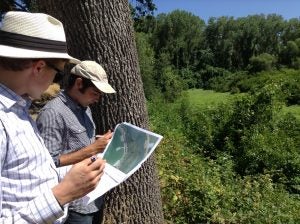
Assessing habitat for songbirds at a ranch in the Central Valley.
The drive through the Central Valley’s mosaic of agricultural land, water infrastructure, riparian zones and floodplains has become a familiar one for me and my colleagues. We meet frequently with landowners who are creating, restoring and protecting habitat for wildlife on these working lands.
At each farm and ranch we visit, I am inspired by the landowners who are stepping up to do what they can for the at-risk species that are a part of the Central Valley’s ecology and history.
Whether they are managing flooded fields for Chinook salmon and giant garter snakes, planting trees for Swainson’s hawks and riparian songbirds to nest, or allowing native milkweed and wildflowers to grow for monarch butterflies to breed and feed, these landowners are showcasing conservation innovations that honor and sustain the region’s natural heritage.
“Farming for the 22nd century”

Learn more about conservation projects at Davis Ranches.
One of these ranches is Davis Ranches, a family farm with a rich legacy of conservation that has been operating since the late 1800s.
“We call it farming for the 22nd century,” said John Brennan, farm manager for Davis Ranches. “This family wants to still be farming this land a hundred years from now, and that means working with tenants and conservation partners to integrate sustainable practices into the working agricultural landscape.”
To do this, Davis Ranches is leveraging new tools that maximize the conservation potential of marginal lands, like those adjacent to rice fields and row crops. These tools and other technical guidance are provided by the Central Valley Habitat Exchange.
In John Brennan’s words, “the exchange shifts the relationship between farmers and conservationists from ‘you can’t do this’ to guiding and supporting the reconciliation of working lands ecology.”
One-stop conservation for landowners, funders and regulators

Explore projects at cvhe.org.
The Central Valley Habitat Exchange is not only a place where landowners can go for resources and guidance on achieving conservation goals. It’s also a place where potential funders or regulators can access project profiles, complete with images, information about the property, an overview of current and potential restoration actions, and data on baseline habitat and projected uplift. Users can also access a project registry, which displays data on all of the exchange’s current habitat projects in a clickable spreadsheet.
The data in the project profiles and registry are the result of assessments by the exchange’s Habitat Quantification Tool (HQT), a robust scientifically based tool developed to accurately assess both quantity and quality of habitat for focal species.
On the Davis Ranches project profile, users can see the HQT in action, with restoration scenarios and projected habitat uplift based on a baseline HQT assessment of the property. Restoration actions such as restoration of vegetation along canals and hedgerow planting are projected to result in a 25 percent improvement in habitat for Swainson’s hawks and a 20 percent improvement for giant garter snakes.
[Tweet “New online hub pairs landowners with conservation investors”]
Always adding value
The consistent and scientific approach of the Central Valley Habitat Exchange is valuable to both landowners and funders by creating a common language for agreeing upon outcomes and tracking progress towards conservation goals.

Several upcoming projects will be part of a Mitigation Credit Agreement (MCA) that the exchange is currently developing for the Mid and Upper Sacramento River Regional Conservation Investment Strategy. This will be the first MCA in California, allowing landowners to create advance mitigation credits for two threatened species: the giant garter snake and Swainson’s hawk.
The exchange has the additional benefits of allowing potential funders to easily compare different projects on the registry, and helping landowners easily communicate the amount of habitat improvement that their projects can provide.
In the coming months, additional projects in both the San Joaquin and Sacramento Valleys will become part of the exchange, adding to the growing database of projects and creating new investment opportunities for funders in need of secure, quantified conservation outcomes.
The Central Valley Habitat Exchange will continue working to create new opportunities for landowners, public and private habitat investors, wildlife agencies, and flood control agencies to collaborate on multi-benefit conservation projects. By bringing these new opportunities to the table, we can help more landowners sustain the region’s natural bounty.
Related:
Crops, water and habitat: This California farmer’s winning trifecta >>
Birds, snakes and butterflies: Farming for more than crops and cash >>
The snake at the crux of California’s wildlife challenge, and the policy that can solve it >>










3 Comments
Great write up —- such important work!
Any work being done in the southern region of the San Joaquin Valley?
Please, what percentage of farms and ranches in the Central Valley have join in this conservation effort? Certainly much more conservation efforts must be applied. There is a hell of a lot of catching up to do!
During the past few decades, hundreds of thousands of acres in the Central Valley have been converted from a semi-arid, natural environment to flat, habitat sterile farm land. Never a thought was given to the results of how farm land conversion would negatively impact the plants and animals that once thrived in these lands. Requiring an EIR do reveal those environmental impacts was rarely considered. The results have been devastating to the creatures that once dwelled on these lands.
Now these same agricultural interests demand even more water, while, at the same time, have converted thousands of additional acreage to farm land DURING the past five year drought!
When will this madness stop?!